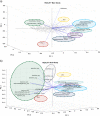Objective wearable measures and subjective questionnaires for predicting response to neurostimulation in people with chronic pain
- PMID: 37340467
- PMCID: PMC10283222
- DOI: 10.1186/s42234-023-00115-4
Objective wearable measures and subjective questionnaires for predicting response to neurostimulation in people with chronic pain
Abstract
Background: Neurostimulation is an effective therapy for treating and management of refractory chronic pain. However, the complex nature of pain and infrequent in-clinic visits, determining subject's long-term response to the therapy remains difficult. Frequent measurement of pain in this population can help with early diagnosis, disease progression monitoring, and evaluating long-term therapeutic efficacy. This paper compares the utilization of the common subjective patient-reported outcomes with objective measures captured through a wearable device for predicting the response to neurostimulation therapy.
Method: Data is from the ongoing international prospective post-market REALITY clinical study, which collects long-term patient-reported outcomes from 557 subjects implanted by Spinal Cord Stimulator (SCS) or Dorsal Root Ganglia (DRG) neurostimulators. The REALITY sub-study was designed for collecting additional wearables data on a subset of 20 participants implanted with SCS devices for up to six months post implantation. We first implemented a combination of dimensionality reduction algorithms and correlation analyses to explore the mathematical relationships between objective wearable data and subjective patient-reported outcomes. We then developed machine learning models to predict therapy outcome based on the subject's response to the numerical rating scale (NRS) or patient global impression of change (PGIC).
Results: Principal component analysis showed that psychological aspects of pain were associated with heart rate variability, while movement-related measures were strongly associated with patient-reported outcomes related to physical function and social role participation. Our machine learning models using objective wearable data predicted PGIC and NRS outcomes with high accuracy without subjective data. The prediction accuracy was higher for PGIC compared with the NRS using subjective-only measures primarily driven by the patient satisfaction feature. Similarly, the PGIC questions reflect an overall change since the study onset and could be a better predictor of long-term neurostimulation therapy outcome.
Conclusions: The significance of this study is to introduce a novel use of wearable data collected from a subset of patients to capture multi-dimensional aspects of pain and compare the prediction power with the subjective data from a larger data set. The discovery of pain digital biomarkers could result in a better understanding of the patient's response to therapy and their general well-being.
Keywords: Chronic pain therapy; Digital biomarkers for pain; Dimensionality reduction; Machine learning; PGIC; Patient-reported outcomes; Predictive modeling; Questionnaire burden; Spinal cord stimulation; Wearable technology.
© 2023. The Author(s).
Conflict of interest statement
SD, AK, and MM are employees of Abbott.
Figures





Similar articles
-
Core patient-reported outcome measures for chronic pain patients treated with spinal cord stimulation or dorsal root ganglia stimulation.Health Qual Life Outcomes. 2023 Jul 20;21(1):77. doi: 10.1186/s12955-023-02158-2. Health Qual Life Outcomes. 2023. PMID: 37474950 Free PMC article.
-
Objective wearable measures correlate with self-reported chronic pain levels in people with spinal cord stimulation systems.NPJ Digit Med. 2023 Aug 15;6(1):146. doi: 10.1038/s41746-023-00892-x. NPJ Digit Med. 2023. PMID: 37582839 Free PMC article.
-
Improved Pain Control with Combination Spinal Cord Stimulator Therapy Utilizing Sub-perception and Traditional Paresthesia Based Waveforms: A Pilot Study.Anesth Pain Med. 2021 Feb 22;11(1):e113089. doi: 10.5812/aapm.113089. eCollection 2021 Feb. Anesth Pain Med. 2021. PMID: 34221951 Free PMC article.
-
The Effectiveness of Dorsal Root Ganglion Neurostimulation for the Treatment of Chronic Pelvic Pain and Chronic Neuropathic Pain of the Lower Extremity: A Comprehensive Review of the Published Data.Pain Med. 2021 Feb 4;22(1):49-59. doi: 10.1093/pm/pnaa369. Pain Med. 2021. PMID: 33260203 Review.
-
Neurostimulation for chronic noncancer pain: an evaluation of the clinical evidence and recommendations for future trial designs.J Neurosurg. 2006 Aug;105(2):175-89. doi: 10.3171/jns.2006.105.2.175. J Neurosurg. 2006. PMID: 17219820 Review.
Cited by
-
Long-term efficacy of 10 kHz spinal cord stimulation in managing painful diabetic neuropathy: A post-study survey.Pain Pract. 2025 Jun;25(5):e70023. doi: 10.1111/papr.70023. Pain Pract. 2025. PMID: 40242901 Free PMC article. Clinical Trial.
-
Predicting chronic pain using wearable devices: a scoping review of sensor capabilities, data security, and standards compliance.Front Digit Health. 2025 May 22;7:1581285. doi: 10.3389/fdgth.2025.1581285. eCollection 2025. Front Digit Health. 2025. PMID: 40475225 Free PMC article.
-
Innovative Applications of Telemedicine and Other Digital Health Solutions in Pain Management: A Literature Review.Pain Ther. 2024 Aug;13(4):791-812. doi: 10.1007/s40122-024-00620-7. Epub 2024 Jun 13. Pain Ther. 2024. PMID: 38869690 Free PMC article. Review.
-
The Application of Artificial Intelligence to Enhance Spinal Cord Stimulation Efficacy for Chronic Pain Management: Current Evidence and Future Directions.Curr Pain Headache Rep. 2025 May 20;29(1):85. doi: 10.1007/s11916-025-01400-4. Curr Pain Headache Rep. 2025. PMID: 40394275 Review.
-
Machine Learning in Pain Neuromodulation.Adv Exp Med Biol. 2024;1462:499-512. doi: 10.1007/978-3-031-64892-2_31. Adv Exp Med Biol. 2024. PMID: 39523286 Free PMC article. Review.
References
-
- Abdi H, Williams LJ. Principal component analysis. Wiley Interdiscip Rev Comput Stat. 2010;2(4):433–459. doi: 10.1002/wics.101. - DOI
-
- Breiman L. Random Forests. Mach Learn. 2001;45(1):5–32. doi: 10.1023/A:1010933404324. - DOI
-
- Caramia C, Torricelli D, Schmid M, Munoz-Gonzalez A, Gonzalez-Vargas J, Grandas F, et al. IMU-based classification of Parkinson's disease from gait: A sensitivity analysis on sensor location and feature selection. IEEE J Biomed Health Inform. 2018;22(6):1765–1774. doi: 10.1109/JBHI.2018.2865218. - DOI - PubMed
LinkOut - more resources
Full Text Sources
Other Literature Sources
